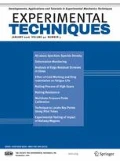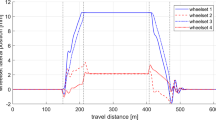Abstract
Railway superstructure components are subject to impact forces caused by irregularities in the rail and wheel or variations in the support stiffness. These imperfections lead to the premature and accelerated deterioration of the track and increase maintenance costs. Generally, to mitigate these dynamic loads, elastomeric rail pads are interposed between rails and sleepers. For each track section, the pad choice is made according to its stiffness, impact attenuation and cost. In this experimental study, eight types of rail pads were characterized using two procedures from EN 13146–3. The results revealed that the rail pad material and geometry affect the impact attenuation ability of the pad and the testing procedure affect the results. It was found that the preload applied is one of the parameters that most affects the impact attenuation value. Appling a preload of 50 kN during the impact attenuation test, which is suggested by the standard, affected this parameter by ranging from between ~2 and ~ 20, depending on the rail pad. Based on these results it is considered that EN 13146–3 should be updated.














Similar content being viewed by others
Abbreviations
- ke :
-
Static stiffness obtained under standard conditions (load range: 18–68 kN)
- ke’ :
-
Static stiffness under non-standard conditions (load range: 1–68 kN
- ke” :
-
Static stiffness under non-standard conditions (load range: 18–35 kN)
- ke”’ :
-
Static stiffness under non-standard conditions (load range: 68–85 kN)
- kdyn,5Hz :
-
Dynamic stiffness for the standard load range (18–68 kN) at 5 Hz
- kdyn,10Hz :
-
Dynamic stiffness for the standard load range (18–68 kN) at 10 Hz
- kdyn,20Hz :
-
Dynamic stiffness for the standard load range (18–68 kN) at 20 Hz
- εUpp,ref,dyn / εLow,ref,dyn :
-
Maximum strain in the upper/lower gauge with the reference rail pad (‘ref’)
- εUpp,ref,st / εLow,ref,st :
-
Static strain in the upper/lower gauge with the reference rail pad (‘ref’)
- εUpp,x,dyn / εLow,x,dyn :
-
Maximum strain in the upper/lower gauge with the tested rail pad (‘x’)
- εUpp,x,st / εLow,x,st :
-
Static strain in the upper/lower gauge with the tested rail pad (‘x’)
- a:
-
Rail pad impact attenuation
- aLow :
-
Rail pad impact attenuation undergone by the lower gauge
- aUpp :
-
Rail pad impact attenuation undergone by the upper gauge
References
Nguyen K, Goicolea JM, Galbadon F (2011) Dynamic effect of high speed railway traffic loads on the ballast track settlement. Congr Métodos Numéricos em Eng
Bosso N, Gugliotta A, Zampieri N (2012) A comprehensive strategy to estimate track condition and its evolution. Int J Railw Technol 1:1–19. https://doi.org/10.4203/ijrt.1.2.1
Indraratna B, Nimbalkar S, Rujikiatkamjorn C (2013) Modernisation of rail tracks for higher speeds and greater freight. Int J Railw Technol 2:1–20. https://doi.org/10.4203/ijrt.2.3.1
Fortunato E, Paixão A, Calçada R (2013) Railway track transition zones: design, construction, monitoring and numerical Modelling. Int J Railw Technol 2:33–58. https://doi.org/10.4203/ijrt.2.4.3
Mezher SB, Connolly DP, Woodward PK et al (2016) Railway critical velocity – analytical prediction and analysis. Transp Geotech 6:84–96. https://doi.org/10.1016/j.trgeo.2015.09.002
Momoya Y, Nakamura T, Fuchigami S, Takahashi T (2016) Improvement of degraded ballasted track to reduce maintenance work. Int J Railw Technol 5:31–54. https://doi.org/10.4203/ijrt.5.3.2
Woodward PK, Laghrouche O, Mezher SB, Connolly DP (2015) Application of coupled train-track Modelling of critical speeds for high-speed trains using three-dimensional non-linear finite elements. Int J Railw Technol 4:1–35. https://doi.org/10.4203/ijrt.4.3.1
Sainz-Aja JA, Pombo J, Tholken D, et al Dynamic calibration of slab track models for railway applications using full- scale testing. Comput Struct Inpress:
Ngo TN, Indraratna B, Rujikiatkamjorn C (2019) Improved performance of ballasted tracks under impact loading by recycled rubber mats. Transp Geotech 20:100239. https://doi.org/10.1016/J.TRGEO.2019.04.002
Bruni S, Anastasopoulos I, Alfi S et al (2009) Effects of train impacts on urban turnouts: Modelling and validation through measurements. J Sound Vib 324:666–689. https://doi.org/10.1016/J.JSV.2009.02.016
Remennikov A, Kaewunruen S (2008) A review of loading conditions for railway track structures due to train and track vertical interaction. Struct Control Heal Monit 15:207–234
Nielsen JCO, Igeland A (1995) Vertical dynamic interaction between train and track influence of wheel and track imperfections. J Sound Vib 187:825–889
Ngamkhanong C, Kaewunruen S (2020) Effects of under sleeper pads on dynamic responses of railway prestressed concrete sleepers subjected to high intensity impact loads. Eng Struct 214:110604. https://doi.org/10.1016/j.engstruct.2020.110604
Vossloh Vossloh Fastening system
PANDROL Pandrol Fastening System. https://www.pandrol.com/products/?prod_main_category=fastening-systems
Sainz-Aja J, Carrascal I, Polanco JA et al (2019) Self-compacting recycled aggregate concrete using out-of-service railway superstructure wastes. J Clean Prod:230. https://doi.org/10.1016/j.jclepro.2019.04.386
Sainz-Aja J, Carrascal I, Polanco JA, Thomas C (2019) Fatigue failure micromechanisms in ed aggregate mortar by μCT analysis. J Build Eng:101027. https://doi.org/10.1016/J.JOBE.2019.101027
Sainz-Aja J, Thomas C, Polanco JA, Carrascal I (2019) High-frequency fatigue testing of recycled aggregate concrete. Appl Sci 10:10. https://doi.org/10.3390/app10010010
Manescu TS, Petre CC, Zaharia NL et al (2009) Dynamic tests for fastening rubber plates to determine attenuation of impact loads. Mater Plast 46:448–451
Remennikov A, Kaewunruen S (2005) Determination of dynamic properties of rail pads using an instrumented hammer impact technique. Acoust Aust 33:63–67
Gómez J, Casado JA, Carrascal IA et al (2019) Experimental validation of a new antivibration elastomeric material fabricated from end-of-life tires for slab track systems with embedded rail. J Test Eval:49. https://doi.org/10.1520/JTE20180804
Ferreño D, Sainz-Aja JA, Carrascal IA, et al Prediction of mechanical properties of rail pads under in-service conditions through machine learning algorithms. Adv Eng Softw
Kaewunruen S, Ngamkhanong C, Papaelias M, Roberts C (2018) Wet/dry influence on behaviors of closed-cell polymeric cross-linked foams under static, dynamic and impact loads. Constr Build Mater 187:1092–1102. https://doi.org/10.1016/j.conbuildmat.2018.08.052
Sainz-Aja JA, Carrascal IA, Ferreño D, et al (2020) Influence of the operational conditions on static and dynamic stiffness of rail pads. Mech Mater 148:
Ngamkhanong C, Ming QY, Li T, Kaewunruen S (2020) Dynamic train-track interactions over railway track stiffness transition zones using baseplate fastening systems. Eng Fail Anal 118:104866. https://doi.org/10.1016/j.engfailanal.2020.104866
Johansson A, Nielsen JCO (2003) Out-of-round railway wheels—wheel-rail contact forces and track response derived from field tests and numerical simulations. Proc Inst Mech Eng Part F J Rail Rapid Transit 217:135–145
Carrascal I, Casado JA, Diego S, Polanco JA (2011) Atenuacion frente a impacto en sistemas de sujecion ferroviaria de alta velocidad. J An Mecan Fract 28:713–718
Sol-Sánchez M, Moreno-Navarro F, Rubio-Gámez MC (2015) The use of elastic elements in railway tracks: a state of the art review. Constr Build Mater 75:293–305. https://doi.org/10.1016/j.conbuildmat.2014.11.027
Ferreño D, Casado J, Carrascal IA et al (2019) Experimental and finite element fatigue assessment of the spring clip of the SKL-1 railway fastening system. Eng Struct 188:553–563. https://doi.org/10.1016/j.engstruct.2019.03.053
Kaewunruen S, Remennikov AM (2006) Sensitivity analysis of free vibration characteristics of an in situ railway concrete sleeper to variations of rail pad parameters. J Sound Vib 298. https://doi.org/10.1016/j.jsv.2006.05.034
Kaewunruen S (2012) Effectiveness of using elastomeric pads to mitigate impact vibration at an urban turnout crossing. Noise Vib Mitig Rail Transp Syst 118:357–365
Fenander Å (1997) Frequency dependent stiffness and damping of railpads. Proc Inst Mech Eng Part F J Rail Rapid Transit 211:51–62. https://doi.org/10.1243/0954409971530897
Cukrowicz KC, Jahn DR, Graham RD et al (2013) Suicide risk in older adults: evaluating models of risk and predicting excess zeros in a primary care sample. J Abnorm Psychol 122:1021–1030. https://doi.org/10.1037/a0034953
Zhu S, Cai C, Luo Z, Liao Z (2015) A frequency and amplitude dependent model of rail pads for the dynamic analysis of train-track interaction. Sci China Technol Sci 58:191–201. https://doi.org/10.1007/s11431-014-5686-y
Wei K, Zhang P, Wang P et al (2016) The influence of amplitude- and frequency-dependent stiffness of rail pads on the random vibration of a vehicle-track coupled system. Shock Vib 2016:1–10. https://doi.org/10.1155/2016/7674124
Wei K, Wang F, Wang P et al (2017) Effect of temperature- and frequency-dependent dynamic properties of rail pads on high-speed vehicle–track coupled vibrations. Veh Syst Dyn 55:351–370. https://doi.org/10.1080/00423114.2016.1267371
CEN [1] EN 13146–3:2012 “Railway applications - Track - Test methods for fastening systems - Part 3: Determination of attenuation of impact loads”
ADIF (2005) ET 03.360.570.0 Placas elásticas de asiento para sujeción VM
CEN (2017) EN 13481–2:2012+A1:2017. Railway applications - Track - Performance requirements for fastening systems - Part 2: Fastening systems for concrete sleepers
(2012) EN 13146–9:2011+A1. Aplicaciones ferroviarias. Vía. Métodos de ensayo de los sistemas de fijación. Parte 9: Dterminación de la rigidez
Kaewunruen S, Remennikov AM (2007) Response and prediction of dynamic characteristics of worn rail pads under static preloads. In: Proceedings of 14th international congress on sound and vibration. Australian Acoustics Society, Cairns, Australia, pp. 1–8
Kaewunruen S, Remennikov AM (2007) Laboratory measurements of dynamic properties of rail pads under incremental preload. In: 19th Australasian conference on the mechanics of structures and materials. Taylor & Francis, Christchurch, pp 319–324
PANDROL (2020) Fastclip FC. https://perma.cc/5U4U-JSYS
Acknowledgments
The authors would like to thank the company PANDROL UK LIMITED (Worksop, UK) for supplying the necessary material for the laboratory tests. Also, authors would like to thank to the LADICIM, Laboratory of Materials Science and Engineering of the University of Cantabria for making available to the authors the facilities used in this research. The authors would like to thank the “Augusto Gonzalez Linares” postdoctoral grant program of the University of Cantabria for their support.
Availability of Data and Material
Data available on request due to privacy restrictions.
Code Availability
Not applicable.
Funding
This research did not receive any specific grant from funding agencies in the public, commercial, or not-for-profit sectors.
Author information
Authors and Affiliations
Corresponding author
Ethics declarations
Conflict of Interest
On behalf of all authors, the corresponding author states that there is no conflict of interest.
Additional information
Publisher’s Note
Springer Nature remains neutral with regard to jurisdictional claims in published maps and institutional affiliations.
Publisher’s Note
Springer Nature remains neutral with regard to jurisdictional claims in published maps and institutional affiliations.
Highlights
• Impact attenuation results depend significantly on testing conditions
• The rail pad impact attenuation strongly depends on the toe load
• A mismatch was observed between the two methods proposed by the EN-13146-3 standard
Rights and permissions
About this article
Cite this article
Carrascal, I., Casado, J., Diego, S. et al. Influence of the Testing Procedure on the Value of the Impact Attenuation of Rail Fastening Systems: an Experimental Study. Exp Tech 46, 167–178 (2022). https://doi.org/10.1007/s40799-021-00468-y
Received:
Accepted:
Published:
Issue Date:
DOI: https://doi.org/10.1007/s40799-021-00468-y




